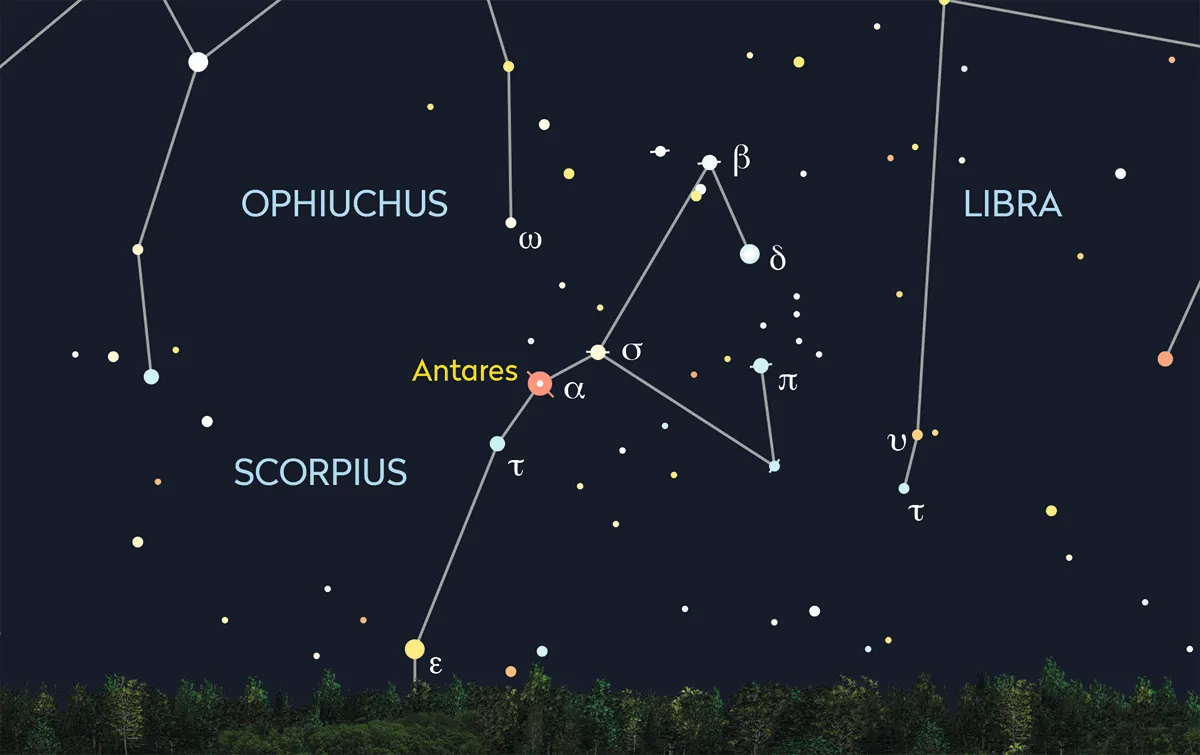Antares is the 15th brightest star in the night sky, standing out like a beacon during the darkness-challenged months of June and July, skirting east to west, low above the southern horizon.
It's the brightest star in Scorpius, one of the best constellations in the night sky, a large and recognisable depiction of the scorpion that mortally wounded Orion, the Hunter.
From northerly latitudes in the Northern Hemisphere, Scorpius is too low to properly appear above the southern horizon in the summer.
We get to see the northern portion, the part that includes the creature’s heart marked by the orange supergiant Antares (Alpha (α) Scorpii).

Facts about star Antares
Antares has a spectral type M1.5Iab-Ib. ‘M1.5’ indicates where it sits on the temperature scale, measuring 3,387˚C, a cool value that gives the star its orange hue.
‘Iab’ is the designation of an intermediate-size luminous supergiant, ‘Ib’ being a less luminous supergiant. Antares is between these designations.
The star is 550 lightyears away and shines at mag. +1.0, with variability between +0.6 and +1.6. It’s about 76,000 times more luminous than our Sun.
The name comes from the visual appearance of the star. Being relatively bright to the naked eye and having an orange hue, it appears similar to how the planet Mars looks to the naked eye.

The name Antares name means ‘rival to Ares’, Ares being the Greek name for Mars, itself referencing the god of war.
It's a binary star, the secondary shining at mag. +5.5 and separated from the primary by 2.6 arcseconds.
While its spectral type of B.25V suggests a blue-white colour, its close proximity to orange Antares creates a colour contrast that causes it to appear blue-green.
For more stars like this, read our guide to observing green stars.
8 facts for beginners
Antares is the brightest star in Scorpius
Antares is the brightest star in the constellation Scorpius and is often called the 'heart of the scorpion' because of its central position in the constellation.
It’s a red supergiant
Antares is a red supergiant star, which means it is much larger and cooler than our Sun. Its red colour is easily visible to the naked eye.
Enormous size
If Antares replaced our Sun, it would extend beyond the orbit of Mars and possibly even reach Jupiter. It has a mass 12 times that of the Sun and is 700 times wider than the Sun.
You can see it with the naked eye
It's is one of the brightest stars in the night sky, ranking around 15th overall. Its brightness varies, but it can be seen with the naked eye.
It's Mars's rival
The name Antares comes from Greek and means “rival of Ares” (Ares is the Greek name for Mars). This is because its red colour can make it look similar to the planet Mars.
It's a binary
Antares is actually two stars: the main red supergiant (Antares A) and a much smaller, faint blue-white companion star (Antares B), though the companion can't be seen without a telescope.
Antares is 550 lightyears distant
The star is about 550 lightyears from Earth, which means the light you see from it left the star over 550 years ago.
Antares will go supernova
The star is nearing the end of its life. In the distant future, it will explode as a supernova, creating a spectacular cosmic event, but this probably won’t happen for at least another million years
This guide originally appeared in the June 2021 issue of BBC Sky at Night Magazine.


